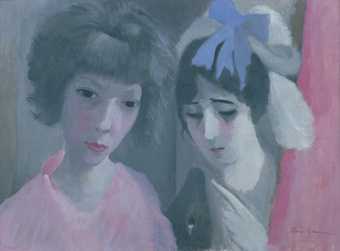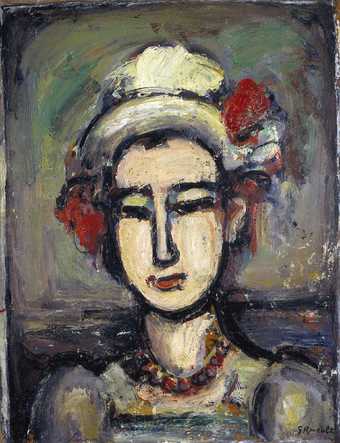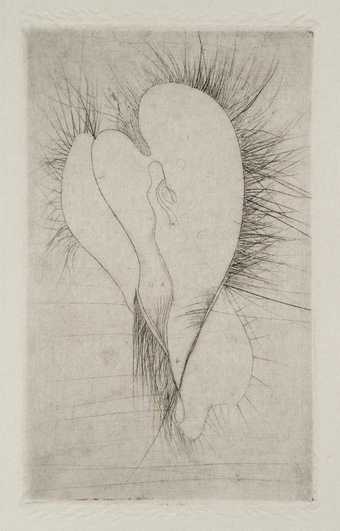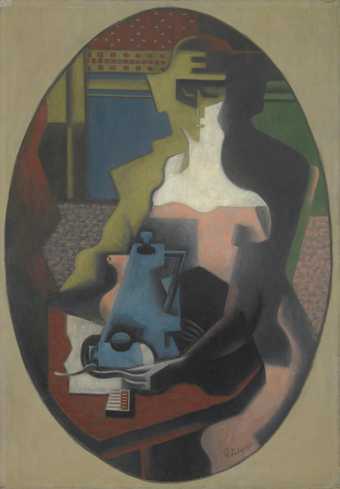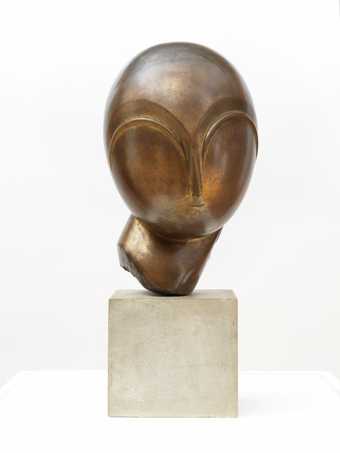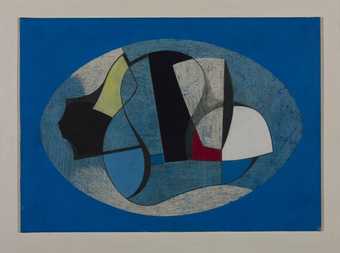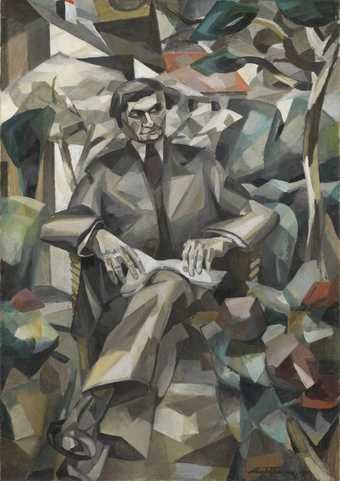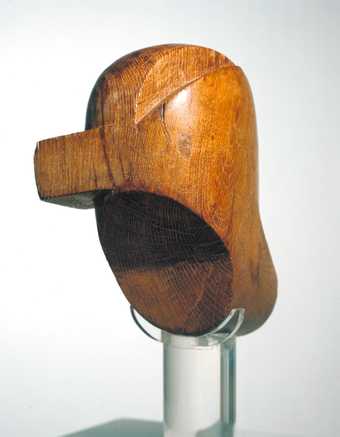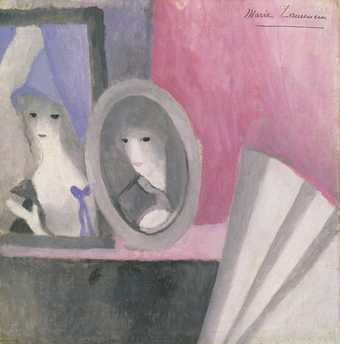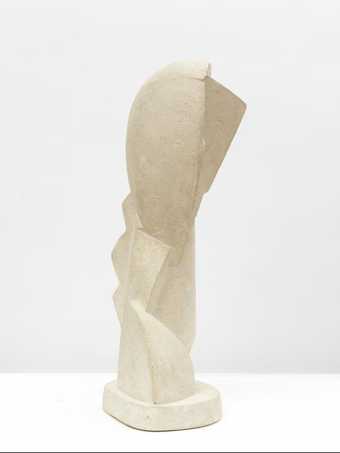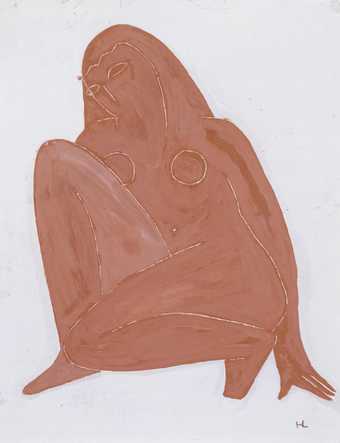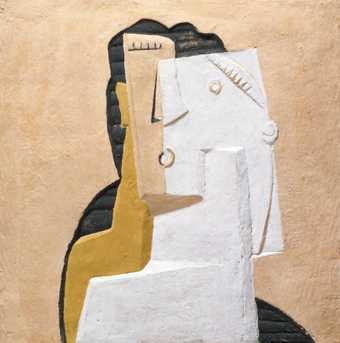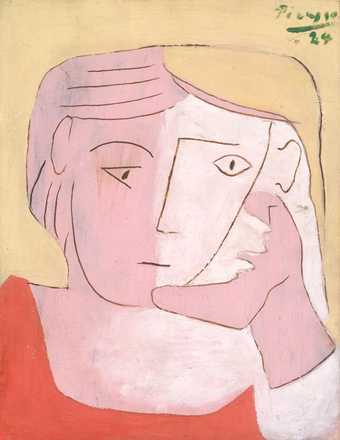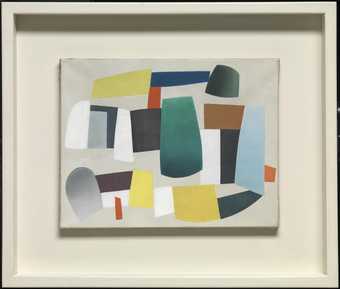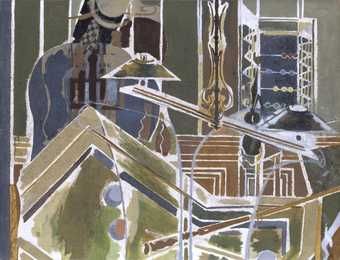
In Tate Modern
- Artist
- Albert Gleizes 1881–1953
- Original title
- Tableau
- Medium
- Gouache on wood
- Dimensions
- Frame: 1124 × 925 mm
support: 921 × 730 mm - Collection
- Tate
- Acquisition
- Purchased 1962
- Reference
- T00550
Summary
Painting 1921 is a large gouache painting on wood by the French artist Albert Gleizes. A series of abstract forms and shapes in various colours are layered in the middle of the image. The composition is centred on a black shape, which shares some organic features with the blue cloud-like form directly behind it and the orange and black striped shape to the right. There is a strong diagonal and vertical movement created by the angles at which some of the forms have been painted. The simple background of the painting, divided into bands of solid colours (blue and teal), helps to fix the composition. The palette is meticulously balanced, with the warm oranges, rich blue and teal contrasting with the paler tones of white, light pink and sandy yellow. Several colours, most notably blue and black, have been used in two separate forms; this sets up a series of echoes and brings cohesion to the image. Gleizes has signed and dated the work in the bottom right corner.
It is uncertain as to where Gleizes painted this image, although from 1920 he used the studio of Jacques Villon Duchamp (1876–1918) in Puteaux, Paris. The gouache has been applied smoothly and the direction of application is visible in many of the larger flat shapes. The white of the ground is visible at the edges of the painting. Gleizes characteristically made several preliminary sketches, often in gouache, before creating a final painting. A small gouache study for Painting, signed and dated 1920, was sold at Sotheby’s on 26 March 1980 (lot 268) and another image entitled Composition was sold at Christie’s on 30 June 1981 (lot 130), although it is unclear if the latter was the same work.
This image has had several titles, including Abstraction, Composition (Tableau) and Composition Picture. Its abstracted shapes may constitute multiple layered portraits of the artist’s wife, as suggested by art historian Daniel Robbins in 1975:
You are quite correct to see a female head in the image. I am sure it is a portrait, and moreover that it is based on Mme Gleizes in a very chic hat. The central image is frontal: a sort of cloche with a foll, a scarf, very like the hats Mme Gleizes still loved to war only a few years ago. The 2nd concentric set is the head again, closer, and the 3rd of course gives an idea of the hair concealed in the hat.
(Quoted in Ronald Alley, Catalogue of the Tate Gallery’s Collection of Modern Art other than Works by British Artists, London 1981, p.289.)
The use of layered planes of colour connects to Gleizes’s ideas about the importance of ‘translation’ and ‘rotation’. As the artist stated in 1937, ‘translation represented an unfolding of planes as seen against a square on the surface of a painting; rotation occurred when these planes began to shift around a central point’ (quoted in Helen Topliss, ‘Anne Dangar at Moly-Sabata: Tradition and Innovation’, undated, http://www.nga.gov.au/dangar/index.cfm#_ftn5, accessed 20 May 2016).
Painting indicates the evolution of Gleizes’s earlier cubist style towards a more austere form of abstraction. Art historian Christopher Green has noted that ‘between 1920 and 1925 [Gleizes] took cubist synthesis towards a level of “purity” beyond Orphism, intent on leading a return to what he believed were the fundamental compositional principles of French wall painting in the thirteenth century’ (Green 2003, p.34). In 1924 Gleizes codified these theories in his book Les Peintures et ses lois, ce qui devait sortir du Cubisme, explaining that ‘one-point perspective had forced painting to become static’, whereas in medieval art ‘there was greater movement and rhythm’ (quoted in Topliss, undated, accessed 20 May 2016). Painting shows a very shallow picture plane and a dramatic break from earlier, more typically cubist paintings by Gleizes, for instance his Portrait of Jacques Nayral 1911 (Tate T02410).
Works such as Painting also show Gleizes’s interest in the synthetic cubist idea of a pictorial reality built up through a synthesis of patterns and layers. However, they also evidence the emergence of a very personal and austere aesthetic based on individual theoretical pursuits and a growing spirituality. Gleizes is largely associated with ‘Salon Cubists’ Jean Metzinger and Robert Delaunay, but he also had ties with dada artists including Marcel Duchamp. The art historian Philip Cooper has pointed out that Gleizes’s paintings of the early 1920s ‘have a strong stylistic resemblance’ to those of the cubist painter Juan Gris (Philip Cooper, Cubism, London 2002, p.58). Painting was exhibited in 1964 as part of the touring retrospective Albert Gleizes 1881–1953, at venues in New York, Paris and Dortmund.
Further reading
Daniel Robbins, Albert Gleizes 1881–1953, exhibition catalogue, Solomon R. Guggenheim Museum, New York 1964, https://archive.org/stream/albertgleizes1881robb#page/n3/mode/2up, accessed 28 May 2016, reproduced p.91.
Douglas Cooper, The Cubist Epoch, London 1994.
Christopher Green, Art in France 1900–1940, New Haven 2003, reproduced p.3.
Jo Kear
May 2016
Supported by Christie’s.
Does this text contain inaccurate information or language that you feel we should improve or change? We would like to hear from you.
Display caption
Gleizes’s abstract paintings often keep strong links with subject matter that inspired them. Here the image may be based on a female head, possibly that of the artist’s wife. Gleizes was a pacifist but was conscripted into the French army in the First World War. Deeply affected by this experience, he became gravely concerned with the future of society. He thought artists could help create a better world, not just by making beautiful things but by offering new ways of looking.
Gallery label, January 2019
Does this text contain inaccurate information or language that you feel we should improve or change? We would like to hear from you.
Catalogue entry
Albert Gleizes 1881-1953
T00550 Tableau
(Painting) 1921
Inscribed 'ALBERT GLEIZES | 1921' b.r.
Tempera on panel, 36 1/4 x 28 3/4 (92 x 73)
Purchased at Sotheby's (Grant-in-Aid) 1962
Prov:
With Léonce Rosenberg, Paris (Galerie de l'Effort Moderne); Dr John Joseph Wardell Power, Jersey, Channel Islands; Power sale, Sotheby's, London, 7 November 1962, lot 17 repr. as 'Abstraction'
Exh:
Albert Gleizes 1881-1953, Guggenheim Museum, New York, September-October 1964 (123, repr.) as 'Composition (Tableau)'; Musée National d'Art Moderne, Paris, December 1964-January 1965 (57, repr.); Museum am Ostwall, Dortmund, March-April 1965 (57, repr.)
Repr:
Bulletin de 'L'Effort Moderne', No.13, March 1925, between pp.8 and 9 as 'Tableau 1921'
Daniel Robbins wrote on 15 October 1975 that it was Gleizes' unvarying practice to develop a work very carefully, and to draw the composition in pencil, and to make several gouaches with varying colour possibilities before doing a final version such as this. He had already found preliminary versions of all the works reproduced on pages 90-1 of his Guggenheim Museum catalogue, except this one.
'You are quite correct to see a female head in the image. I am sure it is a portrait, and moreover that it is based on Mme Gleizes in a very chic hat. The central image is frontal: a sort of cloche with a foll, a scarf, very like the hats Mme Gleizes still loved to wear only a few years ago. The 2nd concentric set is the head again, closer, and the 3rd of course gives an idea of the hair, concealed in the hat.'
A study for it in gouache, 39.5 x 29.5cm and signed and dated 1920, with various minor differences in composition and painted in a colour range of pinks, purples and creamy browns was sold at Sotheby's on 26 March 1980, lot 268 repr.
Published in:
Ronald Alley, Catalogue of the Tate Gallery's Collection of Modern Art other than Works by British Artists, Tate Gallery and Sotheby Parke-Bernet, London 1981, pp.288-9, reproduced p.288
Explore
- abstraction(8,615)
-
- from recognisable sources(3,634)
-
- figure(2,270)
- non-representational(6,161)
-
- colour(2,481)
- geometric(3,072)
- irregular forms(2,007)
- clothing and personal items(5,879)
-
- hat(1,437)
- hair(437)
- head / face(2,497)
You might like
-
Marie Laurencin Portraits (Marie Laurencin, Cecilia de Madrazo and the Dog Coco)
1915 -
Georges Rouault The Italian Woman
1938 -
Wols (Alfred Otto Wolfgang Schulze) [no title]
c.1937–50 -
Jean Metzinger Woman with a Coffee Pot
1919 -
Constantin Brancusi Danaïde
c.1918 -
Arthur Jackson Painting
1937 -
Albert Gleizes Portrait of Jacques Nayral
1911 -
Constantin Brancusi Head
c.1919–23 -
Marie Laurencin The Fan
c.1919 -
Henri Laurens Head of a Young Girl
1920 -
Henri Laurens Seated Woman
c.1926–30 -
Henri Laurens Head of a Boxer
1920, cast 1921 -
Pablo Picasso Head of a Woman
1924 -
Jean Hélion Abstract Composition
1934 -
Georges Braque The Billiard Table
1945

